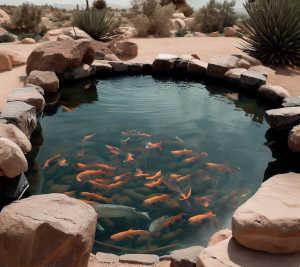Water is a precious resource, and during times of drought, responsible water usage becomes even more critical. For koi enthusiasts and pond owners, maintaining a healthy and thriving aquatic environment for their beloved fish while conserving water can be challenging. However, with the right strategies and careful planning, it's possible to strike a balance between providing optimal conditions for koi and being mindful of water conservation efforts.
Understanding the Challenge
Drought conditions pose a significant threat to both natural water bodies and man-made structures, including koi ponds. Ponds may experience decreased water levels, reduced oxygen levels, and increased concentrations of pollutants due to stagnant water. Koi fish, being sensitive to water quality, can suffer if proper measures are not taken.
Conservation Strategies
- Regular Monitoring: Begin by closely monitoring your koi pond's water levels, temperature, and quality. This will help you understand the changes happening in your pond and make informed decisions.
- Invest in a Water-Friendly Pond Design: If you're planning to build a new koi pond or renovate an existing one, consider incorporating water-saving features like a recirculating filter system, rainwater harvesting, and natural filtration methods. These design elements can help reduce water loss and maintain better water quality.
- Optimize Filtration Systems: Upgrading or optimizing your pond's filtration system can significantly improve water quality. Efficient filters will help keep the water clean and clear, reducing the need for frequent water changes.
- Rainwater Harvesting: During droughts, every drop of rainwater matters. If your local regulations permit, set up rain barrels or collection systems to capture rainwater. This harvested rainwater can be used to top off your koi pond, minimizing the use of treated tap water.
- Shade: Provide shade using plants and structures. Shade reduces evaporation and keeps water temperatures stable.
- Evaporation Control: Using pond covers or floating plants can help reduce water loss due to evaporation. Covering the pond's surface with floating plants not only provides shade but also adds aesthetic value to the pond.
- Use Water Wisely: Be mindful of how you use water around your koi pond. Minimize splashing, avoid overfilling, and ensure that hoses and faucets don't leak.
- Maintain Aeration: Adequate oxygenation is crucial for koi health. Aeration devices, such as air pumps and diffusers, help maintain healthy oxygen levels, reducing the need for frequent water changes.
- Monitor Fish Feeding: Overfeeding koi can lead to excess waste in the pond, deteriorating water quality. Adjust their feeding regimen to ensure they consume all the food, leaving minimal waste behind.
Conserving water during a drought while maintaining a thriving koi pond requires a thoughtful approach that balances the needs of your fish with responsible water usage. By implementing strategies such as rainwater harvesting, efficient filtration, and careful monitoring, pond owners can contribute to water conservation efforts while still providing their koi with a suitable environment. Remember, the key is to find a balance between sustaining your aquatic ecosystem and being a responsible steward of the environment.
